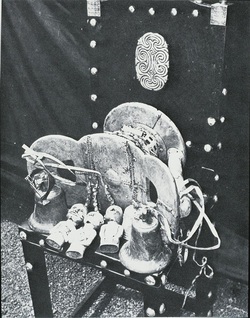The Golden Stool.

Stools are a central symbol among the Akan cultures, and the Asante peoples from Ghana hold true to this idea. Stools serve as a practical and ritual use. They also have a hierarchical meaning symbolizing leadership and royalty. They are carved from a singular piece of wood and are for meant an individual person. Most often, important people such as the Asantehene(King of Asante) have elaborately decorated stools. When someone passes from this world, their stool is blackened. It is said that their soul is transferred to the stool. The stools of kings are kept in what is called the stool room and this is where that particular states dynastic soul and history are stored.[1] The Golden Stool was said to have fallen from the sky right into the lap of Osei Tutu, the first Asantehene. The Golden Stool is spiritually powerful and it holds the history of the Akan people. It enshrines and protects the soul of the Akan nation.[2] The Golden Stool has super natural powers and signifies a code of moral behavior for the Asante people. It has never touched the ground and has its own throne to sit on (pictured left). It has also never been blackened.
Stool: Golden Stool on Hwedomtia Chair, gold, wood, mixed media, (ARTstor Slide Gallery)
[1] Monica Blackmun Visonà, Robin Poynor, and Herbert M. Cole, A History of Art in Africa, (Upper Saddle River, N.J.: Pearson Education, Inc., 2008), 200-201.
[2] Douglas Fraser, "The Symbols of Ashanti Kingship," African Art & Leadership, ed. Douglas Fraser and Herbert M. Cole (Milwaukee, Wisconsin: The University of Wisconsin Press, 1972), 137-152.
Stool: Golden Stool on Hwedomtia Chair, gold, wood, mixed media, (ARTstor Slide Gallery)
[1] Monica Blackmun Visonà, Robin Poynor, and Herbert M. Cole, A History of Art in Africa, (Upper Saddle River, N.J.: Pearson Education, Inc., 2008), 200-201.
[2] Douglas Fraser, "The Symbols of Ashanti Kingship," African Art & Leadership, ed. Douglas Fraser and Herbert M. Cole (Milwaukee, Wisconsin: The University of Wisconsin Press, 1972), 137-152.
